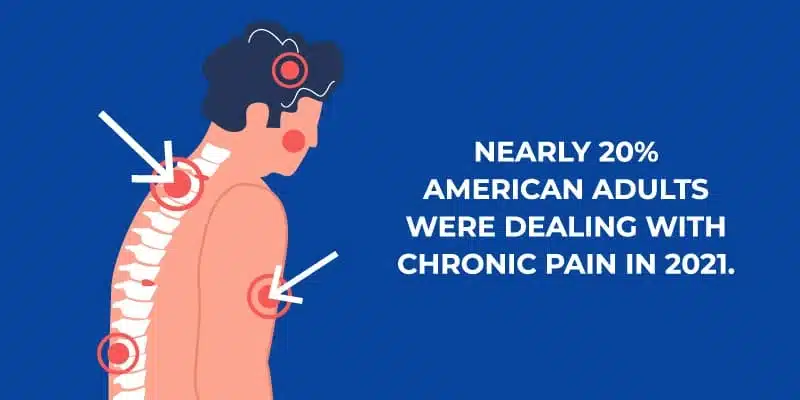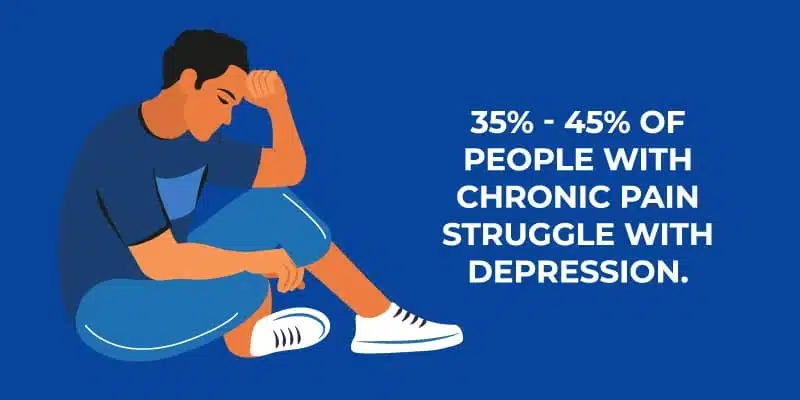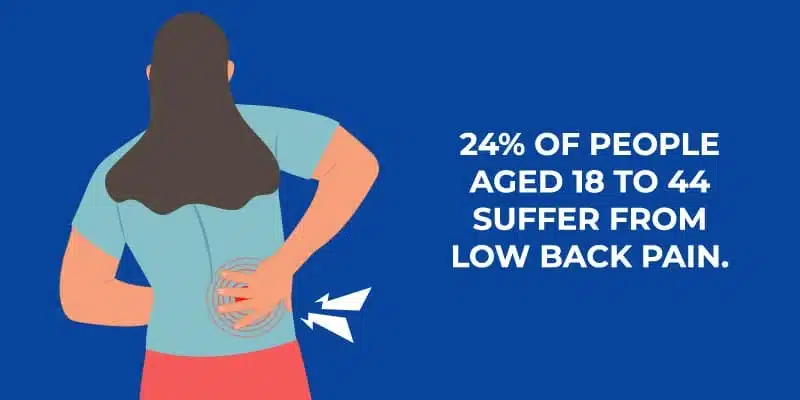Leading Innovations in Chronic Back Pain Treatment
Learn more about different types of chronic back pain treatment and how to find the help you need in this comprehensive article.
Table of Contents
Understanding Pain vs. Chronic Pain
Before exploring chronic back pain treatment, it’s important to understand the different types of pain.
Differentiating Pain and Chronic Pain
Pain is a typical bodily response that alerts you to possible injury. This type of pain, known as acute pain, is often linked to a specific cause, such as a burn, cut, or break. It subsides as your body heals.
For instance, you feel pain when you accidentally touch a hot stove, but the discomfort fades away once your hand recovers.
Differentiating Pain and Chronic Pain
Chronic pain lingers long after an injury has healed or persists, even without a clear origin. It is not only a symptom but rather a condition on its own. If pain extends beyond three months, it is classified as chronic.
Chronic pain, including chronic back pain, can remain even after measures like chronic back pain treatment have been taken. Unlike acute pain, which functions as an alarm system, chronic pain resembles a faulty alarm that keeps ringing without any new injury.

What is Chronic Back Pain?
Chronic back pain is often described as a dull or throbbing ache in the lower back region. It could be constant, or it might come and go, but it’s there often enough to disrupt your day-to-day activities.
Triggers for Chronic Back Pain
There can be several triggers for chronic back pain episodes. These triggers can include:
- Activities that put a strain on your back, such as heavy lifting or prolonged sitting
- Stress
- Tension
Chronic back pain treatment is designed to reduce these symptoms and improve your ability to function.
Radiating Pain
Sometimes chronic back pain may radiate to other parts of the body. For instance, if you have chronic back pain related to a spinal issue, it could radiate down your leg, a condition commonly known as sciatica.
The pain can vary in intensity from a slight nagging discomfort to severe, debilitating pain.1
Sleep Disturbances
Accompanying Symptoms
In some cases, chronic back pain may be accompanied by other symptoms like:
- Fatigue
- Mood changes
- Reduced flexibility or mobility
These symptoms can impact your lifestyle, and they’re taken into account when a healthcare provider is creating a chronic back pain treatment plan.
Prevalence
Chronic back pain affects a vast number of people worldwide. In fact, estimates suggest that about 65% – 80% of the population will experience some form of back pain at least once in their life.
In 2021, nearly 20 out of every 100 American adults, translating to an estimated 54 million people, were dealing with lower back pain. That’s a large number of people whose daily life and productivity were likely affected.
If you consider an age group often associated with active work years, those aged between 18 to 44, almost a quarter (24.4%) suffer from low back pain. This prevalence underscores the pressing need for more effective chronic back pain treatment.
Causes and Risk Factors
While anyone can experience chronic back pain, certain individuals are more susceptible.
Your Age
Age plays a significant role, as the chances of experiencing back pain increase for people over 30 years old.
As you get older, your body naturally undergoes changes that can lead to chronic back pain. For example, the discs in your spine can gradually wear down over time, a condition known as disc degeneration.
This wear and tear process is normal but can sometimes cause chronic back pain.3
Your Job
Your Lifestyle Habits
Lifestyle habits, such as smoking or not exercising, are additional risk factors. Regular exercise helps to keep your back muscles strong and flexible, which can protect against chronic back pain.
On the contrary, smoking can damage tissues in your back, making you more prone to pain.
Your Health Conditions
Health conditions, such as arthritis and obesity, can increase your risk of experiencing back pain.
It’s important to note that anyone can develop chronic back pain. These factors merely increase the likelihood. It’s always advisable to seek chronic back pain treatment if you experience ongoing discomfort.
Your Health Conditions
The Impact of Chronic Back Pain
There are many different consequences of chronic back pain.
Physical Consequences
Chronic back pain can limit your physical abilities. Everyday activities, like lifting groceries or bending to tie your shoes, may become challenging.
This can lead to a decrease in physical fitness, as regular exercise might be too painful.
Chronic back pain treatment aims to reduce this discomfort and help you regain your physical capabilities.
Mental and Emotional Effects
Living with chronic pain can be emotionally draining. It’s not unusual to experience feelings of frustration, anger, anxiety, and even depression.
These feelings can, in turn, make the physical pain feel worse, creating a cycle that’s hard to break. This highlights the importance of addressing the psychological impact in any chronic back pain treatment plan.
Social Implications
Chronic back pain can also affect your social life. You might find yourself turning down invitations to events or gatherings due to your discomfort. This can lead to feelings of isolation or loneliness.
Comprehensive chronic back pain treatment often includes strategies to help you manage your social activities without worsening your pain.
Financial Implications
Chronic back pain can have substantial financial implications. You may face medical costs for:
- Doctor visits
- Medications
- Physical therapy
- Surgery
If the pain affects your ability to work, you might have reduced income. Some chronic back pain treatment options may be costly, but it’s essential to balance these costs against the potential for improved quality of life.
Lifestyle Alterations
Living with chronic back pain often means making changes to your lifestyle. You might need to modify your diet, incorporate regular exercise, or use special tools like ergonomic chairs or beds.
Learning techniques to manage stress could also be a part of your chronic back pain treatment plan. These lifestyle changes, although they may seem minor, can make a big difference in managing your pain and improving your quality of life.

The Importance of Innovations in Chronic Back Pain Treatment
So, treating chronic back pain isn’t as simple as fixing one issue. It’s like solving a tricky puzzle with many different pieces.
Traditional Treatment
In traditional chronic back pain treatment, doctors have relied on methods like medication, physical therapy, or surgery. While these can help, they often don’t address the full scope of the problem.
Some treatments might relieve the pain for a while, but it usually comes back because the root cause is still there. This is where innovative approaches can make a real difference.
The Significance of Innovative Treatment Approaches
Innovative chronic back pain treatment doesn’t just focus on the pain; it looks at the whole picture.
It aims to identify the root causes, which might include things like lifestyle factors, mental health issues, or structural problems in the spine. This kind of treatment is tailored to your needs, so you’re not getting a one-size-fits-all approach.
A major part of these new approaches is the use of a holistic method. This means looking at all areas of your life and health, not just your back pain. By doing this, doctors can address the problem from all sides, helping you achieve a more complete healing process.
Emerging Technologies and Techniques in Back Pain Treatment
New technologies are making chronic back pain treatment more precise and effective.
For example, advanced therapeutic modalities use devices or techniques to help reduce pain and promote healing, such as transcutaneous electrical nerve stimulation (TENS) or ultrasound therapy.7
Minimally Invasive
Some of these technologies allow for minimally invasive procedures. These types of treatments use small incisions or needles to directly target problem areas in your back, which can result in less pain and a faster recovery time.
Treatment Integration
These innovative approaches also integrate non-pharmacological and non-invasive treatments, like cognitive-behavioral therapy or mindfulness practices, into the treatment plan. These can help you manage your pain and improve your well-being.
A Closer Look at TENS
Improving Patient Satisfaction and Outcomes with Innovative Treatment
Imagine going to a doctor who truly understands your pain, listens to your concerns, and crafts a chronic back pain treatment plan just for you. This is the essence of personalized care.
It incorporates empathy and compassion, creating a trusting relationship between you and your healthcare provider. This kind of connection can make your treatment journey more comfortable and less stressful.
Positive Impact on Pain Relief and Functional Improvement
Chronic back pain treatment is not only about pain relief, but it also aims to restore your ability to do everyday activities with ease.
Innovative treatments manage pain symptoms effectively, reducing your reliance on pain medications. Over time, you may find that you’re able to move more freely and enjoy life without the constant worry of back pain.
Promoting Emotional Well-being and Mental Health
By addressing mental health conditions that may co-occur with chronic pain, like anxiety or depression, and providing psychological support, these treatments help you build resilience and coping skills.
Long-Term Success and Sustainable Outcomes
Innovative chronic back pain treatments don’t just provide temporary relief, but they also promote long-term success.
The comprehensive approach of personalized care focuses on providing the right tools and resources to prevent future episodes of pain and encourage self-care habits that maintain your health and well-being over the long term.
Long-Term Success and Sustainable Outcomes
Innovative chronic back pain treatments don’t just provide temporary relief, but they also promote long-term success.
The comprehensive approach of personalized care focuses on providing the right tools and resources to prevent future episodes of pain and encourage self-care habits that maintain your health and well-being over the long term.

Individual Patient Condition and Treatment Effectiveness
When you have back pain, it can feel anywhere from a little annoying to absolutely unbearable. The level of this discomfort, or severity, can influence how a chronic back pain treatment works for you.
What Influences Effectiveness?
Mild pain might be eased by physical therapy, while more severe pain may require a combination of treatments. The individual condition and response to the treatment can also influence effectiveness.
If you have other health conditions, they can affect your chronic back treatment. For example, diabetes can slow down your body’s ability to recover, which might mean your treatment takes longer to help.
If you live with a condition like depression or anxiety, they could make your back pain feel more intense and complicate treatment.
What Happens at Initial Chronic Back Pain Treatment?
When you first start treatment for chronic back pain, your doctor will take steps to understand your pain better. They’ll ask about your symptoms, how and when they started, and what activities or events seem to make them worse.
Your doctor may also order physical tests such as an X-ray or MRI scan to get a better understanding of the cause of your pain. After that, they’ll recommend specific treatments for you, based on their assessment and your individual needs.
Measuring and Evaluating Treatment Success
Knowing if your chronic back pain treatment is working can sometimes be simple. You might notice that your pain is getting less intense or that you can perform activities with ease. Other times, it’s not so simple, and your doctor may need to measure your progress in other ways.
Your doctor might ask if you’ve been able to do more physical activity than you did before the treatment began or use a pain scale to see if there’s been any improvement in your level of pain. They may even ask you to fill out a questionnaire or conduct specific tests.
Depending on the treatments you’ve chosen, it can take a few weeks or longer for you to notice an improvement. Your doctor may need to adjust your treatments if they don’t seem effective after some time has passed.
Surgical vs. Non-Surgical Treatment Opportunities
When it comes to chronic back pain treatment, there are two main routes to explore: surgical and non-surgical options. Both ways have their own advantages and challenges.
The best option for you depends on the specifics of your back pain and what you and your doctor decide is the right path for you.
Surgical Interventions for Chronic Back Pain
Surgical chronic back pain treatment can range from minimally invasive procedures to major surgery, depending on your specific case.
These interventions are often used when other treatments haven’t worked or if your back pain is caused by something that needs to be fixed with surgery.
For example, if you have a herniated disc causing your pain, a surgeon might remove the part of the disc that’s pushing on your nerves. In some cases, spinal fusion surgery may be the best option to stabilize your spine and relieve your chronic back pain.
Non-Surgical Approaches and Therapies
Non-surgical treatments are often the first line of defense against chronic back pain. These can include things like physical therapy, where you learn exercises to strengthen your back and improve flexibility, and medication to help control the pain.
Other non-surgical options might be things like chiropractic care, massage, acupuncture, and even some lifestyle changes such as maintaining a healthy weight and quitting smoking.
What Happens During Acupuncture?
Considering the Best Treatment Option for Different Types of Pain
Deciding on the best chronic back pain treatment can depend on the type of pain you’re experiencing. For example, surgical treatment might be best if you have a serious condition causing your pain, like a herniated disc or spinal stenosis.
But, if you’re dealing with more general types of pain, such as muscle strain or tension, physical therapy, and lifestyle changes may be more appropriate.

Innovative Treatment Opportunities at J. Flowers Health Institute
J.Flowers Health Institute has set a new standard in the field of health care with its unique approach to treating chronic pain, mental health issues, and more.
The institute, located in the heart of the Texas Medical Center in Houston, Texas, offers a range of programs with a unique focus on individual needs.
Comprehensive Diagnostic Evaluation Program
When you come to J. Flowers Health Institute, the team starts with a “Living MRI.” They review your medical history and design an evaluation plan just for you. This team could include doctors, therapists, and dieticians, among others.
After the review, you will undergo a detailed diagnostic evaluation. This will help the team understand exactly what is right or wrong with your body, mind, and spirit.
Once the evaluation is complete, the team creates a treatment plan tailored to you. The treatment suggested could vary depending on your individual needs. It could be anything from the Bespoke Stabilization Program to outpatient programs.
Innovative Treatment Approaches
At J. Flowers Health Institute, the team uses innovative chronic back pain treatment approaches.
Bespoke Stabilization Program
One such approach is the Bespoke Stabilization Program. This is a private and personalized medical experience.
A specialist will monitor your needs, including medication, vital signs, nutritional intake, and sleep patterns, round the clock.
The goal is to make sure you are ready, both medically and mentally, before the team diagnoses or recommends an appropriate treatment plan.
Bespoke Wellness and Restoration Program
Another innovative approach is the Bespoke Wellness and Restoration Program. This program aims to address your unique recovery needs.
This could be improving your mental, emotional, and physical wellness, or helping you return to work or school.
Bespoke Continuing Care Program
J. Flowers Health Institute also offers a Bespoke Continuing Care Program. This program allows you to return home while still receiving support from the team.
They will continue to connect with you even after you return home, ensuring you are on track toward optimal health.
All these programs focus on providing you with the best chronic back pain treatment. They all aim to improve your health and life quality.
Contact J. Flowers Health Today
You don’t have to struggle with chronic back pain alone. Reach out to us today for more information.
Resources
- https://www.pennmedicine.org/for-patients-and-visitors/patient-information/conditions-treated-a-to-z/sciatica
- https://www.ncbi.nlm.nih.gov/pmc/articles/PMC3082679/
- https://www.pennmedicine.org/updates/blogs/musculoskeletal-and-rheumatology/2018/november/disc-degeneration-can-cause-back-pain-as-you-age
- https://www.healthline.com/health/lower-back-pain-when-sitting l
- https://www.verywellhealth.com/obesity-and-back-pain-297008
- https://www.ncbi.nlm.nih.gov/pmc/articles/PMC4530716/
- https://www.webmd.com/back-pain/guide/tens-for-back-pain
- https://www.psychiatry.org/news-room/apa-blogs/chronic-pain-and-mental-health-interconnected






